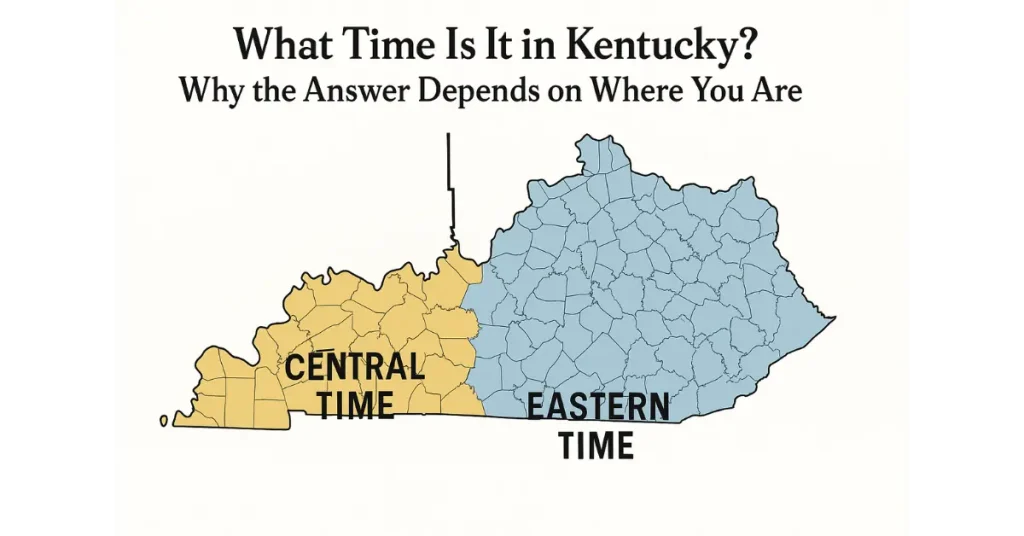If you’ve ever tried to figure out what time it is in Kentucky, you might have been surprised to find there’s no single answer. That’s because Kentucky isn’t served by just one but two time zones. It’s one of those quirks of geography and history that adds a bit of complexity to day-to-day life, travel, and scheduling across the state.
Whether you’re catching a flight, planning a business call, or checking up on friends and family, understanding the Kentucky time zone split is essential. So, if you want to know the time in KY right now, or you’re curious about the time zone of Kentucky, USA in general, let’s dig into the details, explore the difference between the Louisville KY time zone and others, and clarify why Central vs Eastern time in Kentucky matters more than you might think.
Kentucky’s Time Zone Split: A Tale of Two Zones
First off, the key to unlocking the mystery lies in knowing that Kentucky is divided between the Eastern Time Zone and the Central Time Zone.
- Eastern Time Zone: The majority of the state, including big cities like Lexington, Frankfort (the state capital), and Louisville, observes Eastern Time – either Eastern Standard Time (EST) or Eastern Daylight Time (EDT) in summer months.
- Central Time Zone: The western part of Kentucky, covering cities like Bowling Green, Hopkinsville, and Paducah, follows Central Time – Central Standard Time (CST) or Central Daylight Time (CDT).
This division means that if you’re asking what time it is in Kentucky without specifying where, you’ll get two different answers!
Why Kentucky Has Two Time Zones
This time zone split reflects Kentucky’s geography and historical ties.
- The state stretches across a wide east-west expanse, bordering ten states. Western Kentucky aligns more closely with the Central Time Zone states like Tennessee.
- Eastern Kentucky shares cultural and economic ties with states on Eastern Time like Ohio and West Virginia.
This geographic split dates back many decades but remains relevant today because it affects everything from television schedules to government office hours. It’s also a reason why Kentucky time zone map guides are so useful to residents and visitors alike.
Louisville Time Zone vs. Lexington Time Zone: Same or Different?
A very common question arises: Is Louisville in the same time zone as Lexington?
Both cities—and the great majority of population centers in Kentucky’s central and eastern regions—are in the Eastern Time Zone. So, if you’re in Louisville or Lexington KY, you’re on the same clock.
- During Standard Time (roughly November to March): EST (UTC -5)
- During Daylight Saving Time (from March to November): EDT (UTC -4)
If you’re comparing these cities with, say, Bowling Green or Owensboro, you’ll need to account for the one-hour difference during the year.
Central vs Eastern Time Kentucky: The Time Difference
The key practical difference between the two zones is a standard one-hour gap. When clocks say noon in Louisville, it’s only 11 a.m. in Bowling Green during:
- Standard Time (November through early March)
- Daylight Saving Time (mid-March through early November)—both zones spring ahead or fall back together, preserving that hour difference.
This time difference may seem minor, but it can cause confusing moments when scheduling across the state:
- Businesses operating statewide must specify what zone a meeting is in.
- Travelers driving across the time zone line will “gain” or “lose” an hour.
- Broadcast schedules often report both times for clarity.
Kentucky Cities in Central Time: Who’s on What Clock?
Here’s a handy look at some Kentucky cities in Central Time:
- Bowling Green
- Hopkinsville
- Owensboro
- Paducah
- Murray
- Hopkinsville
- Henderson
Meanwhile, cities like:
- Louisville
- Lexington
- Frankfort
- Covington
- Ashland
Are all firmly in the Eastern Time Zone.
Knowing where you are on the Kentucky time zone map helps avoid mix-ups.
What Time Is It in Lexington KY, Right Now?
If you want to check the current time in Lexington, KY , for planning or connecting with someone, keep this in mind:
- Lexington always observes Eastern Time (EST or EDT).
- As of this writing in late July 2025, Lexington is on Eastern Daylight Time (EDT), which is UTC -4.
So, when it’s noon in London (UTC +1 during British Summer Time), it’s 7 a.m. in Lexington.
Current Time in Bowling Green, KY: A Snapshot
Contrast that to Bowling Green, KY, located in the Central Time Zone:
- In late July 2025, Bowling Green is on Central Daylight Time (CDT), which is UTC -5.
- Therefore, when it’s noon in Lexington, it will be 11 a.m. in Bowling Green.
This time shift doesn’t just influence daily life but touches transportation schedules, event planning, and broadcasts statewide.
Why Does the Kentucky Time Zone Difference Matter?
You might think the hour difference is just a curiosity, but it carries real implications for many residents and businesses.
For Travelers and Commuters
Crossing from one time zone to another within Kentucky might confuse your watch or phone clock. A business trip from Louisville (Eastern Time) to Owensboro (Central Time) means arriving “an hour earlier” or “later” by the clock than your watch suggests.
For Broadcast and Sports Fans
If you’re flipping between TV channels for sports events or news, understanding that some sports teams and news outlets report times in Eastern or Central Time is helpful—especially for regional games or state-wide coverage.
For Businesses Spanning Both Zones
When scheduling meetings or deliveries across the state, clear communication about the time zone ensures punctuality and reduces scheduling headaches.
How Do Daylight Saving Time Changes Affect Kentucky?
Kentucky, like many US states, observes Daylight Saving Time (DST). This means:
- Clocks “spring forward” one hour in early March (2025: March 9)
- Clocks “fall back” one hour in early November (2025: November 2)
Both Eastern and Central Time Zones in Kentucky observe DST simultaneously, maintaining the one-hour difference all year.
Is There a Push to Change the Time Zones in Kentucky?
From time to time, there are debates in Kentucky about whether the whole state should stick to one zone for clarity and simplicity. Some argue that:
- Unifying under Eastern Time would mean less confusion for business and travel.
- However, Western Kentucky’s proximity to Central Time neighboring states makes changing less practical for that region.
As of 2025, Kentucky remains split, respecting both geographic and cultural differences.

Two Perspectives: Living With Kentucky’s Time Zone Split
Perspective One: Celebrating Regional Identity
Some see the split as a reflection of Kentucky’s rich diversity—different communities with distinct ties, rhythms, and traditions. The time zones mark natural boundaries rather than barriers, embracing the state’s variety.
Perspective Two: A Nuisance of Modern Life
Others find the split a source of daily hassle—it messes up appointments, confuses deliveries, and complicates digital scheduling apps that don’t always adjust properly. They advocate for a uniform time zone but recognize the complexity in achieving that.
Both views highlight the ongoing balancing act between tradition, convenience, and geography.
Practical Tips: How to Navigate Kentucky’s Time Zones
If you live in Kentucky, or plan to visit or do business there, here are some tips to keep your time—and sanity—straight:
- Always Check the City: Use “time in KY” tools that specify the city, not just the state.
- Confirm Meeting Times: When invited to events or meetings, ask if the time stated is Eastern or Central.
- Use Your Smart Devices: Phones and computers usually update automatically, but double-check appointments in calendar apps.
- Give Extra Buffer: When traveling across time zones, leave plenty of time to account for the clock change.
- Communicate Clearly: If working across the zones, specify times with “ET” or “CT” to avoid confusion.
- Know the Big Hubs: Louisville and Lexington are Eastern Time, Bowling Green and its neighboring towns are Central Time.
Conclusion: Time in Kentucky — More Than Just Numbers on a Clock
So, what time is it in Kentucky? The honest answer is—it depends on where you are in the state! Kentucky’s position at a crossroads of time zones gives it a unique character and occasional quirks. Whether you find yourself watching the clock in Louisville or setting an alarm for a trip to Bowling Green, knowing the Kentucky time zone differences makes all the difference in staying punctual and connected.
As the world grows more connected yet schedules become more complex, these split time zones become more than just trivia; they’re part of how Kentuckians live, work, and celebrate together across this beautiful and varied state.
Next time someone asks you about the time zone of Kentucky, USA, you can explain warmly that it’s a place of two times but one heart.

